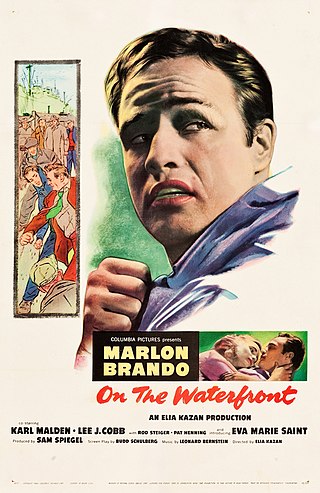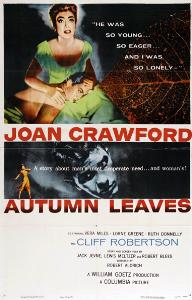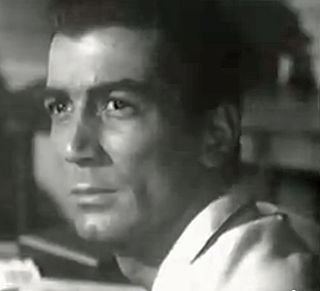
On the Waterfront is a 1954 American crime drama film, directed by Elia Kazan and written by Budd Schulberg. It stars Marlon Brando and features Karl Malden, Lee J. Cobb, Rod Steiger, Pat Henning, and Eva Marie Saint in her film debut. The musical score was composed by Leonard Bernstein. The film was inspired by "Crime on the Waterfront" by Malcolm Johnson, a series of articles published in November–December 1948 in the New York Sun which won the 1949 Pulitzer Prize for Local Reporting, but the screenplay by Budd Schulberg is directly based on his own original story. The film focuses on union violence and corruption amongst longshoremen, while detailing widespread corruption, extortion, and racketeering on the waterfronts of Hoboken, New Jersey.
Columbia Pictures Industries, Inc. is an American film production studio that is a member of the Sony Pictures Motion Picture Group, a division of Sony Pictures Entertainment, which is one of the Big Five studios and a subsidiary of the multinational conglomerate Sony.

Rita Hayworth was an American actress, dancer and producer. She achieved fame during the 1940s as one of the era's top stars, appearing in 61 films over 37 years. The press coined the term "The Love Goddess" to describe Hayworth after she had become the most glamorous screen idol of the 1940s. She was the top pin-up girl for GIs during World War II.

Robert Burgess Aldrich was an American film director, producer, screenwriter and assistant director. A maverick director working in a myriad of genres, he worked mainly in film noir, war movies, and dark melodramas with Gothic overtones. His notable credits include Vera Cruz (1954), Kiss Me Deadly (1955), The Big Knife (1955), Autumn Leaves (1956), Attack (1956), What Ever Happened to Baby Jane? (1962), Hush...Hush, Sweet Charlotte (1964), The Flight of the Phoenix (1965), The Dirty Dozen (1967), and The Longest Yard (1974).

Harry Cohn was a co-founder, president, and production director of Columbia Pictures Corporation.

Too Late the Hero is a 1970 American war film directed by Robert Aldrich and starring Michael Caine, Cliff Robertson, Ian Bannen and Harry Andrews.

Autumn Leaves is a 1956 American psychological drama film directed by Robert Aldrich and starring Joan Crawford in an older woman/younger man tale of mental illness. The film was distributed by Columbia Pictures. The screenplay was written by Jean Rouverol and Hugo Butler, though it was credited to Jack Jevne, since Rouverol and Butler were blacklisted at the time of the film's release.

Sam Katzman was an American film producer and director. Katzman produced low-budget genre films, including serials, which had disproportionately high returns for the studios and his financial backers.

The Yakuza is a 1974 neo-noir crime drama film directed by Sydney Pollack and starring Robert Mitchum, Ken Takakura and Brian Keith. The screenplay by Paul Schrader and Robert Towne is from a story by Schrader's brother, Leonard Schrader.

Sheena, also known as Sheena: Queen of the Jungle, is a 1984 superhero film based on a comic-book character that first appeared in the late 1930s, Sheena, Queen of the Jungle.

King Kong Lives is a 1986 American monster adventure film directed by John Guillermin. Produced by De Laurentiis Entertainment Group and featuring special effects by Carlo Rambaldi, the film stars Linda Hamilton and Brian Kerwin. The film is a sequel to the 1976 remake of King Kong. This was the final Kong film in which the eponymous character was portrayed using suits and practical effects, further films would utilize computer animation.
The 3 Worlds of Gulliver is a 1960 Eastmancolor Columbia Pictures fantasy film loosely based upon the 1726 novel Gulliver's Travels by Jonathan Swift. The film stars Kerwin Mathews as the title character, June Thorburn as his fiancée Elizabeth, and child actress Sherry Alberoni as Glumdalclitch.

Kerwin Mathews was an American actor best known for playing the titular heroes in The 7th Voyage of Sinbad (1958), The Three Worlds of Gulliver (1960) and Jack the Giant Killer (1962).

Big Leaguer is a 1953 American sports drama film starring Edward G. Robinson and was the first film directed by Robert Aldrich.

Charles Hirsch Schneer was an American film producer, best known for working with Ray Harryhausen, the specialist known for his work in stop motion model animation.

...All the Marbles is a 1981 American comedy-drama film about the trials and travails of a female wrestling tag team and their manager. It was directed by Robert Aldrich and stars Peter Falk, Vicki Frederick and Laurene Landon. The Pittsburgh Steeler hall of famer "Mean" Joe Greene plays himself.

Ray Danton was a radio, film, stage, and television actor, director, and producer whose most famous roles were in the screen biographies The Rise and Fall of Legs Diamond (1960) and The George Raft Story (1962). He was married to actress Julie Adams from 1954 to 1981.

The Grissom Gang is a 1971 American crime neo noir directed and produced by Robert Aldrich from a screenplay by Leon Griffiths. The film is the second adaptation of the 1939 novel No Orchids for Miss Blandish by James Hadley Chase; a previous version had been made in Britain in 1948. The cast includes Kim Darby, Scott Wilson, Tony Musante, Robert Lansing, Irene Dailey, Connie Stevens, Wesley Addy, Joey Faye and Ralph Waite.

The Angry Hills is a 1959 American-British war film directed by Robert Aldrich and starring Robert Mitchum, Stanley Baker and Elisabeth Müller. It is based on the novel by Leon Uris.
The Last Blitzkrieg is a 1959 World War II film produced by Sam Katzman and filmed at Veluwe and the Cinetone Studios in Amsterdam for a Columbia Pictures release.
















